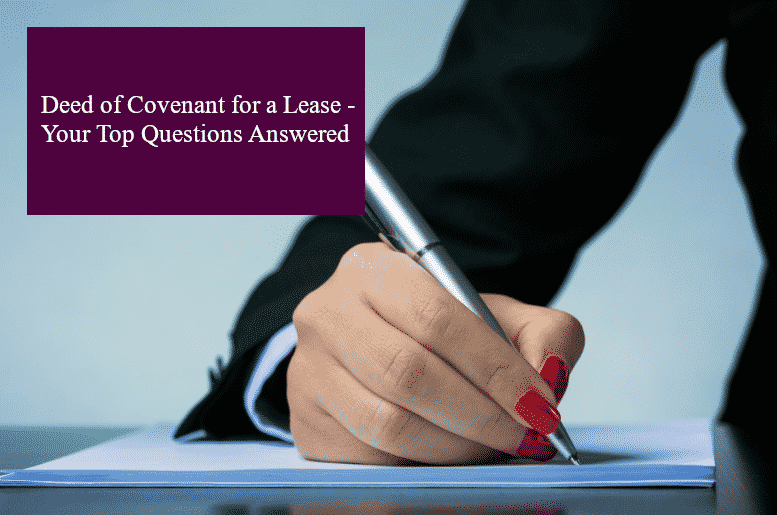What is a Deed of Covenant for a Lease? Your Top Questions Answered
Posted by David Cammack on March 3, 2021

1. What is a Deed of Covenant for a Lease?
Where you have long leasehold property, this sort of deed may be required from the person to whom you are selling your property title. Generally the lease will state whether you require one. It is a short document which the new owner would sign to say that they agree to be bound by certain terms in the lease. For example, such terms might be:
- the requirement to pay the ground rent to the landlord and to pay the service charges levied each year to the management company; and / or
- various other ‘positive’ covenants with which the new tenant will have to comply (these are ones under which the tenant will need to spend money to comply with them).
2. What is the meaning of “Deed of Covenant”?
A deed of covenant might mean several different types of document. It is where one person agrees to do something or be bound by a contract or certain terms that they were not already a party to. In the context of a leasehold property, such a deed is generally the document you need when the lease requires the new owner to confirm that he or she agrees to certain terms in the lease.
Here’s a Wikipedia article on deeds of covenant that explains further: https://en.wikipedia.org/wiki/Covenant_(law)#England_and_Wales
3. When would you need a Deed of Covenant?
The lease to your leasehold property should state whether or not you need a deed of covenant. This would apply only when you are transferring the title to the flat to someone new. You will need to check the terms of the lease carefully. Otherwise when you tell the landlord you are transferring the title, he might ask for a deed of covenant. There might also be a small administration fee to pay the landlord at that point.
As a technical point, a deed of covenant should not be needed for a lease granted on or after 1 January 1996 (see section 12 of the The Landlord & Tenant (Covenants) Act 1995), but newer leases might state that they require them and certainly older leases will require them still. For a newer lease, it is easier to comply with the requirement, than to argue that you don’t need one.
4. What should you do if you need a Deed of Covenant for a Lease?
If you’ve been asked to produce a deed of covenant, the simplest way is using our Deed of Covenant template. You will find it easy to use to produce your own document in a few minutes. It comes with a guide to talk you through what you need to do. You can then submit it to the landlord and pay the administration fee charged, if there is one.

5. Who pays for a Deed of Covenant?
If the landlord has a standard version for a deed of covenant that it requires you to use, then usually the current owner of the flat will pay the fee (if there is one) to the landlord for the draft deed of covenant. It is often a good idea to enquire as soon as possible about the fee in relation to a Deed of Covenant and whether the landlord has a standard version for you to use. The fee for a draft Deed of Covenant from a landlord is typically around £150 to £200.
6. What are the advantages and disadvantages to a Deed of Covenant?
This really is not the right question. The right question to ask is simply do I need a deed of covenant? If you are a tenant, who has been required in your lease to provide such a deed before you can sell your flat, then you need one. A failure to sign the deed, when required by the terms of the lease to do so, can mean a breach of the lease and might prevent your selling the flat.
7. What are the five most common deeds of covenant?
99% of deeds of covenant are deeds of covenant about a property, mainly being leasehold property. They are promises that the new tenant will comply with certain positive obligations in the lease which might otherwise not be binding on the new tenant. Here are 4 common positive restrictions relating to (usually leasehold) property that would require a deed of covenant from the new tenant, so the new tenant was bound by them:
- An obligation about maintaining boundaries and boundary fences.
- A duty to pay towards the maintenance of estate roads.
- An obligation to maintain any shared walls.
- A situation where there is a “flying freehold” – where both parties agree to maintain different floors of the property and share the costs. This is a less common situation to the ones above.
The fifth most common use does not relate to leasehold property, but might be a situation where someone is lending a machine to someone so that person can evaluate whether to buy it, and the lender requires the borrower to sign a deed of covenant that they will not damage, steal or reverse-engineer the machine. You can imagine this situation is not all that common.
8. What homeowners can do if their landlord doesn’t give them covenants for their house?
Where there is a leased flat and the lease requires a deed of covenant from any new tenant who is buying the flat, if the landlord fails to send over its preferred version, then the tenant should (a) produce their own deed of covenant (perhaps using Legalo’s template) (b) get it signed by the new tenant, and (c) submit it to the landlord, in order to comply with the terms of their lease.
9. How the lease is affected by giving or failing to provide a deed of covenant?
As mentioned above, ‘giving’ the deed of covenant will normally be a contractual requirement of the lease of your flat. A ‘failure’ to provide one will be a breach of the terms of the lease. A failure to provide such a deed can mean an inability to sell your flat to a new tenant.
10. What are some provisions that can be found in them?
The typical deed of covenant will typically have at least the following provisions:
- Listing the parties to the deed: e.g. the landlord, the current tenant and the new tenant.
- Identifying the property in question: the address of the property.
- The most important component: a clause stating that the new tenant agrees to the positive obligations in the lease.
Legalo’s template overs all of these essential points.
If you have further questions about Deeds of Covenant for Leases, please contact us and we’ll do our best to help you.